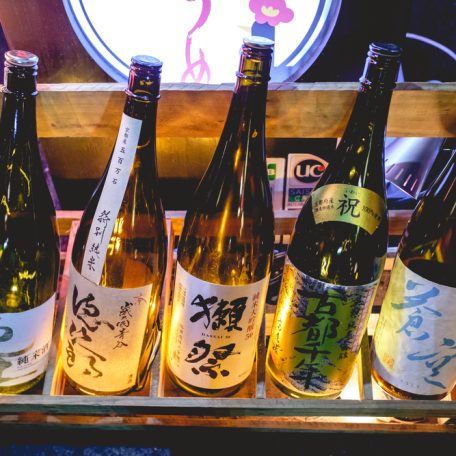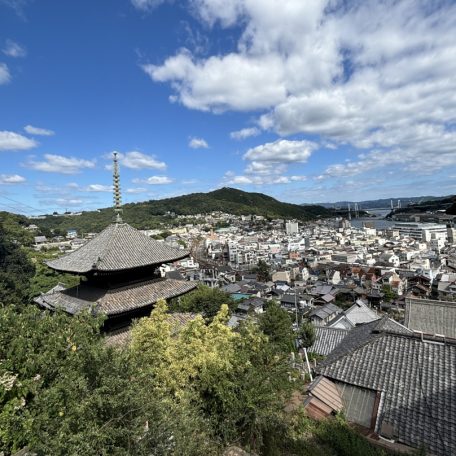Top 5 Traditional Foods in Hiroshima
Feb 13, 2020
BY Darren

In Hiroshima, Japan after World War II, the proud people of this historical city took great effort to rebuild it. Destroyed monuments of Hiroshima’s historical heritage, like Hiroshima Castle and Shukkeien Garden, were reconstructed. While the people of Hiroshima took pride in rebuilding the city, others took traditional Hiroshima food to another level. Here, I will explain the top 5 traditional food dishes that you must try while you are exploring Hiroshima Prefecture during your vacation.

Okonomiyaki / Hiroshimayaki
This pride and joy of Hiroshima is also known as a Japanese layered pancake. It is my favorite meal here in Hiroshima, and in all of Japan. Okonomiyaki is the greatest savory pancake that includes cabbage, pork, noodles, shrimp, and egg. This steamy hot, scrumptious, juicy, and crunchy meal can feed 2 people, but I can devour one all alone. It is that yummy!
Okonomiyaki became popular in Japan during World War II when there was a short supply of rice. This Hiroshima meal can be eaten at any time of the day, especially if you have any leftovers from breakfast. Because of how filling it is, okonomiyaki was often served as a snack to children. Today, cabbage appears to be the only required ingredient. The rest are “as you like it” (literal meaning of ‘okonomi’), although some specialty ingredients will make it taste a little more “authentic.” Okonomiyaki sauce, aonori (green seaweed flakes), and katsuobushi (dried shaved bonito flakes) can be purchased at many Asian grocery stores or online.

Oysters
Oysters in Hiroshima are so big, juicy, and fresh that they make for another must-have meal while indulging yourself in Hiroshima’s best foods. This area is the biggest producer of oysters in Japan, and you can eat them in many ways, raw with soy sauce or ponzu citrus sauce being the most common way. There is also yakigaki, which are grilled oysters. When oysters are grilled with the shell on top of charcoal or wood for barbecuing, they become incredibly sweet and the delicious aroma is multiplied a hundredfold. Next up is the kaki-fry (deep fried oysters) which are recommended for those who do not like raw seafood or shellfish. Hiroshima-style Kaki-fry are made with batter and breadcrumbs that make them light and crunchy on the outside, and hot and juicy on the inside.
You can also try kaki-meshi (oyster bowls), a combination of rice with oysters. The recipe varies depending on the restaurant, but generally, the rice is flavored with sake and soy sauce. It is a must-have in Hiroshima, especially when the restaurant uses Hiroshima’s own specialty sake. Last but not least is the Kaki-nabe (oyster soup or stew), my favorite dish to have during the cold Hiroshima winter. This meal will definitely make you feel warm and tingly with its rich and tasty flavors that you will crave whenever you feel cold. Kaki-nabe is made with oysters, miso, vegetables, and other seasonings to keep you coming back for more. Another way to try Hiroshima oysters are in an okonomiyaki (my favorite way to eat an okonomiyaki, hint, hint)

Hiroshima Sake
Many famous people have visited this country to try the food that has had everyone in the whole world talking and traveling to Japan for. Besides the food in Hiroshima, sake is a must-have drink in Japan, especially Hiroshima sake. It can be drunk hot, at room temperature, or cold. In Japan, it is often served as part of a ceremony where it is warmed in a small jar or bottle, and then sipped from a small cup called a sakazuki. Even U.S. President Obama and Prime Minister Shinzō Abe have had a round of Hiroshima’s own sake.
Within Hiroshima Prefecture you will find Saijo, a town known for brewing sake with 7 old breweries within a small distance from each other. Some of these breweries are over 100 years old, and the newest one is over 50 years old. There are many sake breweries in Japan, but those in Saijo are the best of the best. Why is Saijo’s sake the best in Japan? It is thanks to the water. The town is famous for its excellent clear, clean spring water. You’ll see evidence of this with all the wells throughout the town and people bringing jugs to get the best and freshest water to bring back home to drink.

Hiroshima Tsukemen
Hiroshima tsukemen (dipping noodle) is a dish that speaks for itself. If you like spicy foods like I do, this another must-have dish. Just the experience itself will make you feel like a local in Hiroshima. Being able to slurp as loudly as you want while dipping these noodles into spicy sauce is a meal like no other on the planet. Tsukemen is served with the noodles and broth in two separate bowls instead of mixed together in one bowl. You can choose the spiciness level from mild to extreme by choosing a number between 0 and 100! Tsukemen broth is made from a combination of rayu chili oil, soup stock, soy sauce and vinegar. One dip into this broth gives each mouthful of noodles a spicy but refreshing kick that will make you want to order another bowl maybe even with a higher intensity level.

Momiji Manju
Momiji manju was first created in the late Meiji Period (1868-1912). It is made by wrapping azuki bean jam in dough made from wheat, eggs, sugar and honey. The dough is shaped like a momiji or maple leaf. There are also versions that have lemons and mandarin orange in them, which are Hiroshima specialty produce. Momiji manju’s smooth anko red bean filling is called koshian, and it’s a treat that you must try after all the other dishes and drinks mentioned above. It can be thought of as a donut or pastry filled with sweet red bean jam, and is perfect for those with a sweet tooth.
Momiji manji is loved by the locals and all of Japan. The maple leaf shape of the bun came from the image of actual maple leaves at ‘Momiji-dani,’ a place in Miyajima that is surrounded by Japanese maple trees. Miyajima is a small historic town in the Hiroshima Prefecture that everyone must visit when in the area. Momiji manju remains a popular souvenir sweet of Hiroshima that has not changed with the passage of time. As a top representative of Japanese manju as a whole, momiji manju can be enjoyed with azuki bean paste or as mentioned with a number of other flavors.
Want to discover all the delicious food and sake that Hiroshima has to offer? Be sure to follow your local guide on our Best of Hiroshima Food Tour.
Book your pocket wifi now to stay connected through your entire Japan Journey!

Be sure to get the JR Pass to make navigating Japan during your trip that much easier!

YOU MIGHT ALSO LIKE




